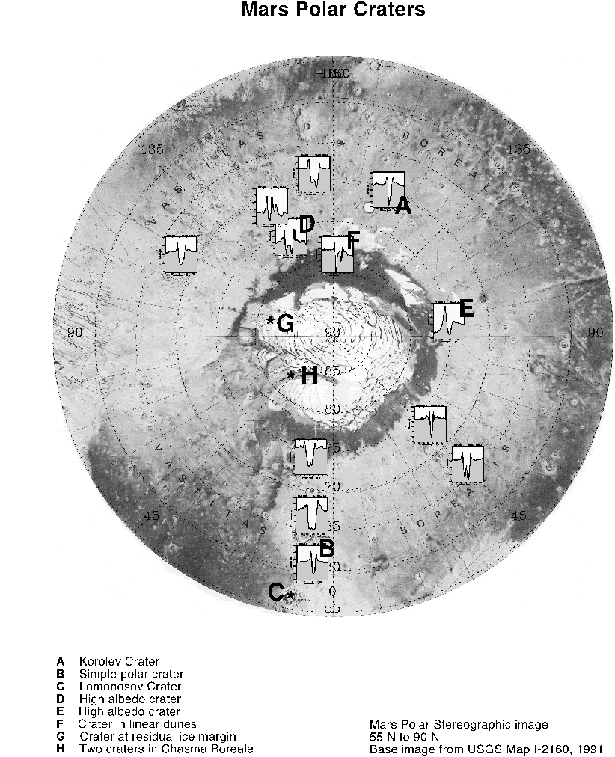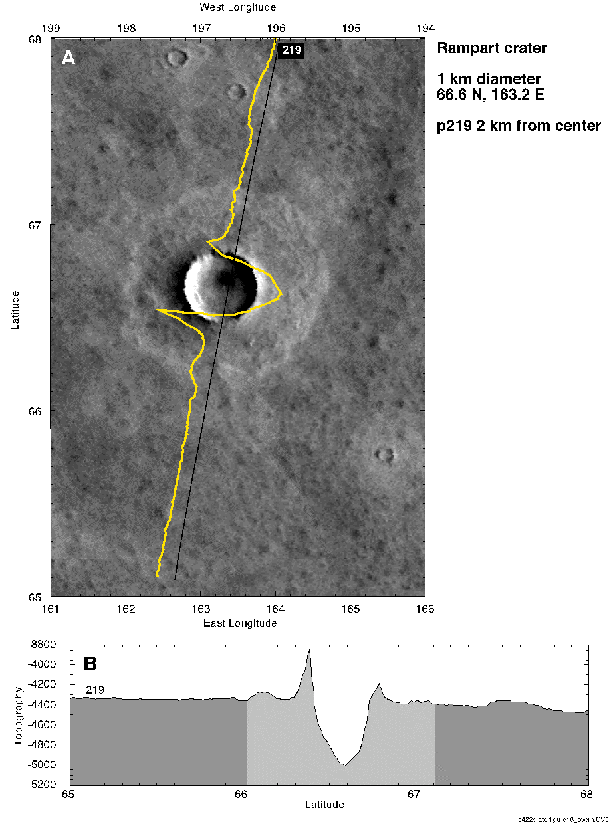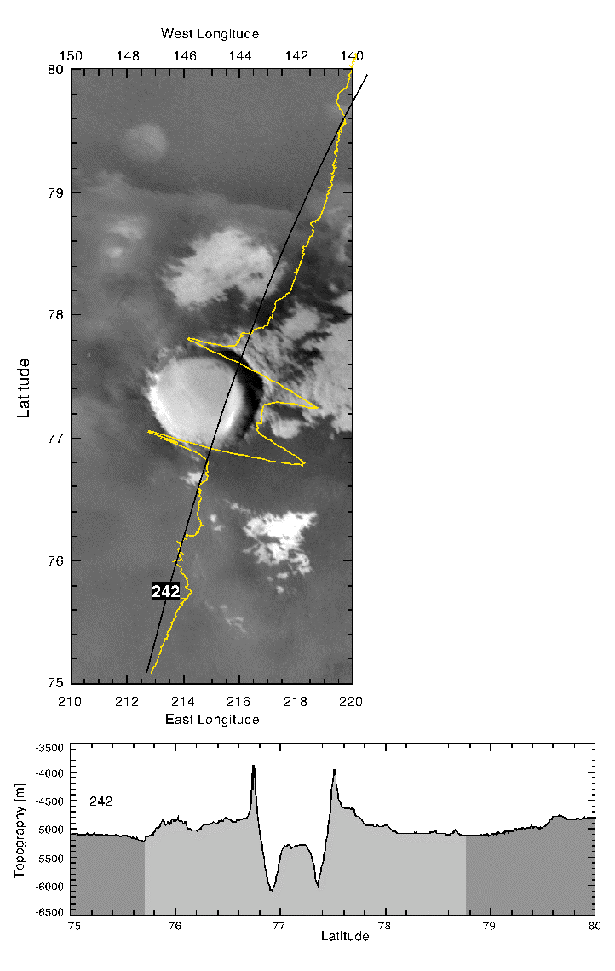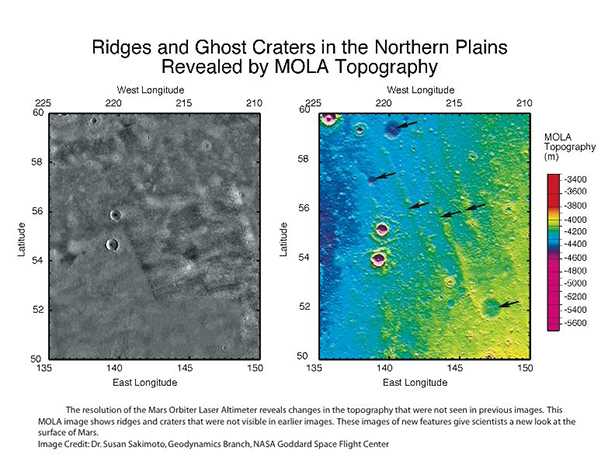 |
National Aeronautics and Space Administration Goddard Space Flight Center |
SEARCH NASA |

 MOLA MOLA |

MOLA has traversed over 100 polar region impact craters during
its operations as part of the Mars Global Surveyor Science Phasing
Orbit period (April-Sept. 1998). Of those sampled, several frost-mantled
craters were crossed, as well as examples of fluidized ejecta and
pedestal craters. This figure is a map of the North Polar region of
Mars north of 55° (N latitude) on which are displayed 12
"thumbnail" MOLA profiles of impact crater cross-sections. All thumbnail
MOLA Profiles are at their own scales, so that some of the craters
illustrated are relatively small (B), while others such as Korolev
(crater just above the letter A in the figure) are 80 km in diameter.
Craters designated with alphabetic letters are particularly interesting.
For example, the craters indicated by D and F in the polar stereographic
map, are frost-mantled and display anomalously large crater cavity
interior deposits. A classic multilobed, fluidized-ejecta crater
is shown to the lower right, just southeast of the margin of the
martian north polar cap. Many of the impact features north of around
60 degrees North latitude on Mars have large rim relief and rapidly
decaying ejecta deposits, relative to similar diameter craters sampled
by MOLA in the equatorial and mid-latitudes. Enhanced pile-up of materials
near the crater rim and anomalously large central cavity deposits
(and uplifts) are characteristic of 30% of the impact features observed
in the high northern latitudes. Some of the craters show evidence
of nearly complete interior infill and subsequent loss of materials, as
if these craters are now in the process of being exhumed. The larger
craters at these high northern latitudes (Korolev, Lomonosov, etc.)
also appear to "bottom out" at similar absolute elevations, suggesting
that there may be a characteristic thickness of an upper crustal
"weak layer" which is underlain by more competent, higher strength
target materials. Results of MOLA analyses of these polar craters will
be presented at the First International Conference on Mars Polar
Science as well as at the Fall 1998 American Geophysical Union meeting.
A research article is in final preparation for Meteoritics and Planetary
Science (Garvin et al., Geometric Properties of Polar Region Impact
Craters on Mars).

MOLA traversed a classic "pedestal" or pancake crater
on Mars Global Surveyor orbit 219.
Such features were first observed by the Viking Orbiters in the
1970's and have been difficult to interpret because
their appearance suggests that large areas of the surrounding
terrain has been stripped away. The debate continues as to the
mechanism by which they appear to be perched much like a pancake
with a hole in the middle in the martian northern high latitudes. MOLA
topographic cross-sections such as this (and dozens of others now
in hand) reveal the always elusive third dimension of these
enigmatic landforms. This crater is approximately 24 km in
diameter and 786 m deep (from its rim crest to its floor). The
most interesting feature one sees is the 100 m tall "rampart" at the
southern edge of the ejecta. Indeed, the ejecta is only slightly
elevated above the surrounding northern plains (10's of meters), but
the distal edge of the ejecta is distinctive, and notably different
from the more subdued northern edge. The suggestion is that such
pedestals form via a fluidization process that generates ramparts
at the ejecta runout margin. Flank slopes on the ejecta blanket
are 0.1° to 0.3°, less than that for more typical craters
of this size. MOLA data allow one to see the subtleties of ejecta
blanket topology and to provide constraints for models of ejecta
emplacement.

On Mars Global Surveyor orbit 242, MOLA traversed this 49 km diameter impact feature in a region of Mars adjacent to the North Polar Cap. This frost-filled crater is located at 77.3°N, 214.5°E, and MOLA's cross-section is within about 10 km of the centerline of the feature. Viking era images of this relatively large and fresh-appearing crater indicated a smooth, homogeneous, and low relief crater floor, and a subdued rim. MOLA measurements show otherwise. The crater is 2.16 km deep, with a typical rim height of 1.2 km, and the slope of the continuous ejecta is approx. 1.3 degrees. The ejecta thickness decays from the rim crest in a fashion that suggests a relatively shallow fall-off with distance, unlike many other polar region martian impact features. Other than Korolev, an 80 km diameter crater at similar latitudes, this is the largest recognized impact crater adjacent to the North Polar Cap. Furthermore, it displays a 660 m tall central uplift structure that takes up about 30% of the cavity volume, which is more than a factor of 2 higher than that observed using MOLA data for most martian craters. In addition, the geometry of the cavity and the central peak are unusual, with a far greater tendency to be "U" shaped than is typical. One suggestion to explain the anomalous geometric properties of this feature could involve the exhumation of the crater from beneath a continuous mantle of polar ice deposits, preferentially leaving behind an ice mantle associated with the central uplift. If this were the case, then a cavity over 2 km in depth would have been filled and subsequent ablation required to produce the present-day topographic expression. Alternately, enhancement and oversteepening of the central uplift could have been associated with enhanced flow and fluidization in the floor rebound process; this could also explain the relatively large rim heights for this feature. Ramparts as high as 300 m are associated with this impact feature; such relief is also atypical of martian impact craters. Indeed, other frost-filled craters traversed by MOLA suggest extreme enhancement of central uplift deposits. The MOLA profile also indicates that the crater sites in a regional sag over 100 km in diameter, perhaps associated with the impact process at these latitudes.
 Download a PDF image comparing Viking and MOLA images of craters.
Download a PDF image comparing Viking and MOLA images of craters.
Information presented here was provided by J.B. Garvin. More information on craters viewed by MOLA will be presented in an article by Garvin, J.B. et al., Geophys. Res. Lett., in press, 1998.
